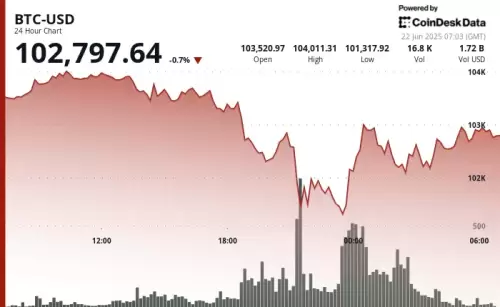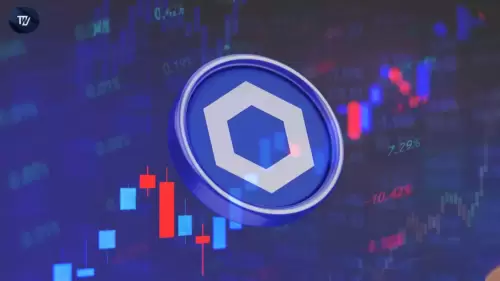 |
|
 |
|
 |
|
 |
|
 |
|
 |
|
 |
|
 |
|
 |
|
 |
|
 |
|
 |
|
 |
|
 |
|
 |
|
暗号通貨の世界では、PIネットワーク、大いに誇張されたモバイルマイニングプロジェクトがトークン価格が崩れるのを見たため、別の注意物語が展開されました。

The cryptocurrency world is no stranger to hype cycles, but few projects have seen such a dramatic build-up of anticipation as Pi Network. The Stanford-born mobile mining project, which launched in 2019, promised to bring cryptocurrency to the masses through a minimal effort 'mining' system accessible through a smartphone app.
暗号通貨の世界は誇大広告サイクルに慣れている人ではありませんが、PIネットワークのような期待の劇的な蓄積を見たプロジェクトはほとんどありません。 2019年に開始されたスタンフォード生まれのモバイルマイニングプロジェクトは、スマートフォンアプリを通じてアクセス可能な最小限の「マイニング」システムを通じて、大衆に暗号通貨をもたらすことを約束しました。
Over three years later, and with over 35 million users engaging in daily routines on the app to collect the Pi token, the project’s ‘enclosed mainnet’ period—where tokens couldn’t be traded on major exchanges—saw the token reach prices of $20-$100 on various gray markets.
3年以上後、3,500万人以上のユーザーがアプリで毎日のルーチンに従事してPIトークンを収集することで、プロジェクトの「囲まれたメインネット」期間(トークンが主要な交換で取引できなかった)が、さまざまな灰色の市場で20〜100ドルの価格に達することができます。
But as institutions go, the startup has been slow to integrate with the broader crypto ecosystem. Despite rumors of an imminent open mainnet launch and potential exchange listings earlier in 2023, the Pi Core Team announced on June 15th a two-phase migration process for gradually converting Pi to an open network.
しかし、機関が進むにつれて、スタートアップはより広範な暗号エコシステムとの統合が遅くなっています。 2023年の初めに、差し迫ったオープンメインネットの打ち上げと潜在的な交換リストの噂にもかかわらず、PIコアチームは6月15日にPIをオープンネットワークに徐々に変換するための2フェーズ移行プロセスを発表しました。
The announcement, which also touched upon KYC procedures and potential transfer limits for the token, was met with immediate disappointment from the community who had been anticipating more immediate launch details.
KYCの手順とトークンの潜在的な転送制限にも触れた発表は、より即時の打ち上げの詳細を予想していたコミュニティからの即座の失望を抱えて満たされました。
In the immediate aftermath, the brunt of the fallout was felt in the rapid collapse of gray market prices.
直後に、灰色の市場価格の急速な崩壊で放射性降下物の矢面が感じられました。
Before the announcement, the bulk of unofficial Pi trading was taking place in Telegram groups and smaller platforms, with the token changing hands at rates that varied wildly.
発表の前に、非公式のPI取引の大部分は電報グループと小規模なプラットフォームで行われていました。
“The gray market prices were completely divorced from reality,” explains blockchain analyst Mark Jefferies of CryptoInsight.
「グレー市場の価格は現実から完全に離婚しました」と、CryptoInsightのブロックチェーンアナリストのMark Jefferiesは説明します。
“They reflected pure speculation based on promises rather than actual adoption or use cases. In essence, it was a classic case of a narrative-driven token, which becomes dangerous when the narrative shifts.”
「彼らは、実際の養子縁組やユースケースではなく、約束に基づいた純粋な推測を反映していました。本質的に、それは物語主導のトークンの古典的なケースであり、物語が変わると危険になります。」
This speculative bubble reached its peak in early 2023 when rumors swirled about an imminent open mainnet launch and potential exchange listings, pushing gray market prices to their all-time highs.
この投機的バブルは、2023年初頭に、差し迫ったオープンメインネットの打ち上げと潜在的な交換リストについての噂が渦巻いて、灰色の市場価格を史上最高に押し上げたときにピークに達しました。
The stage was set for either a spectacular validation or a painful reckoning of the community’s high expectations.
このステージは、壮大な検証またはコミュニティの高い期待の痛みを伴う計算のいずれかに設定されていました。
However, the announcement on June 15th ultimately failed to deliver on the hopes of millions of Pi users. Instead of revealing launch details for major exchanges or full mainnet functionality, the Pi Core Team introduced a two-phase migration process that would gradually convert Pi from its current enclosed mainnet version to an open network.
しかし、6月15日の発表は、最終的に何百万人ものPIユーザーの希望を実現できませんでした。 PIコアチームは、主要な交換または完全なメインネット機能の発売詳細を明らかにする代わりに、2フェーズ移行プロセスを導入し、PIを現在の囲まれたメインネットバージョンからオープンネットワークに徐々に変換しました。
Crucially, the announcement contained no timeline for when Pi would actually become tradeable on major exchanges, nor did it mention any partnerships with established platforms. This omission was particularly glaring given the rumors that had been circulating in recent months about pending listings on Binance, Huobi, and other leading exchanges.
重要なことに、この発表には、PIが実際に主要な交換で取引可能になる時期のタイムラインも含まれておらず、確立されたプラットフォームとのパートナーシップについても言及していませんでした。この省略は、Binance、Huobi、およびその他の主要な交換に関する保留中のリストについて、ここ数ヶ月で流通していた噂を考えると、特に明白でした。
The market reaction was swift and brutal. Within hours of the announcement, gray market prices collapsed by over 80% as disillusioned investors rushed to unload their holdings.
市場の反応は迅速で残忍でした。発表から数時間以内に、幻滅した投資家が保有を降ろすために急いでいるため、灰色の市場価格は80%以上崩壊しました。
“It was like watching a slow-motion train wreck,” recalls Raj Patel, a Pi trader who lost nearly $15,000 in paper value.
「それはスローモーション列車の難破船を見るようなものでした」と、紙の価値で15,000ドル近くを失ったPIトレーダーのRaj Patelは回想します。
“The Telegram groups went from celebratory mood to panicked selling within minutes. It was total chaos as people tried to offload their Pi at any price.”
「テレグラムグループは、お祝いのムードから数分以内に販売をパニックに陥るようになりました。人々がどんな価格でもPIをオフロードしようとしたのは完全な混乱でした。」
Even more concerning were reports of a 400% increase in Pi-related scam complaints in the days following the announcement, according to blockchain forensics firm Chainalysis.
ブロックチェーンフォレンジック企業のチェーンオリシスによると、さらに懸念されるのは、発表後数日でPI関連詐欺の苦情が400%増加したという報告でした。
As disappointed community members grew desperate for any news of the token’s listing, several fake “Pi listing” websites and email scams emerged, preying on the community’s anxieties.
失望したコミュニティのメンバーは、トークンのリストのあらゆるニュースに必死になり、いくつかの偽の「PIリスティング」Webサイトと電子メール詐欺が現れ、コミュニティの不安を食い物にしました。
Several structural flaws in Pi Network’s model made this price collapse almost inevitable. Unlike traditional cryptocurrencies that derive value from network usage and scarcity mechanisms, Pi’s value proposition was almost entirely based on future promises.
PIネットワークのモデルのいくつかの構造的欠陥により、この価格崩壊はほとんど避けられませんでした。ネットワークの使用や希少なメカニズムから価値を導き出す従来の暗号通貨とは異なり、PIの価値提案はほぼ完全に将来の約束に基づいていました。
The project’s unique “mobile mining” approach, while innovative, created billions of tokens with no real-world utility or use case outside of speculative trading.
このプロジェクトのユニークな「モバイルマイニング」アプローチは、革新的ではありますが、投機的取引以外の現実世界のユーティリティまたはユースケースのない数十億トークンを作成しました。
“Pi Network fell into the classic trap of prioritizing user growth over token economics,” notes Dr. Sarah Zhang of the Blockchain Innovation Lab.
「PIネットワークは、トークン経済学よりもユーザーの成長を優先するという古典的なtrapに分類されました」と、ブロックチェーンイノベーションラボのサラチャン博士は述べています。
“By giving away tokens so freely through their mining app, they essentially guaranteed massive sell pressure whenever trading finally became possible.”
「マイニングアプリを通じてトークンを自由に配ることで、取引が最終的に可能になったときはいつでも、本質的に大規模な売りのプレッシャーを保証しました。」
Compounding this problem was the project’s opaque governance structure and lack of transparency about the token distribution. Only 20% of the total token supply was allocated to users through the mining program, with the remaining 80% reserved for the core team, future development, and an initiative called the “Community Node Program.”
この問題を悪化させるのは、プロジェクトの不透明なガバナンス構造とトークン分布に関する透明性の欠如でした。総トークン供給の20%のみがマイニングプログラムを通じてユーザーに割り当てられ、残りの80%はコアチーム、将来の開発、および「コミュニティノードプログラム」と呼ばれるイニシアチブに予約されています。
These structural weaknesses became more apparent when the promised “open market” launch failed to materialize in the announced next phase of the network. Despite hinting at the possibility of early access to a limited number of users, the statement made no mention of any specific plans for expanding the network or integrating it with major exchanges.
これらの構造的な弱点は、約束された「公開市場」の打ち上げが、ネットワークの次の段階で実現できなかったときにより明確になりました。限られた数のユーザーへの早期アクセスの可能性を示唆しているにもかかわらず、この声明は、ネットワークを拡張したり、主要な交換と統合するための特定の計画について言及していませんでした。
In the days following the price collapse, the Pi community fractured into various factions. Some loyalists remained optimistic, attributing the delay to the complexities of launching such a large-scale project. They
価格崩壊後の数日間、PIコミュニティはさまざまな派ionsに骨折しました。一部のロイヤリストは楽観的であり続け、そのような大規模なプロジェクトを開始する複雑さに遅れがあると考えていました。彼らは
免責事項:info@kdj.com
提供される情報は取引に関するアドバイスではありません。 kdj.com は、この記事で提供される情報に基づいて行われた投資に対して一切の責任を負いません。暗号通貨は変動性が高いため、十分な調査を行った上で慎重に投資することを強くお勧めします。
このウェブサイトで使用されているコンテンツが著作権を侵害していると思われる場合は、直ちに当社 (info@kdj.com) までご連絡ください。速やかに削除させていただきます。






























































